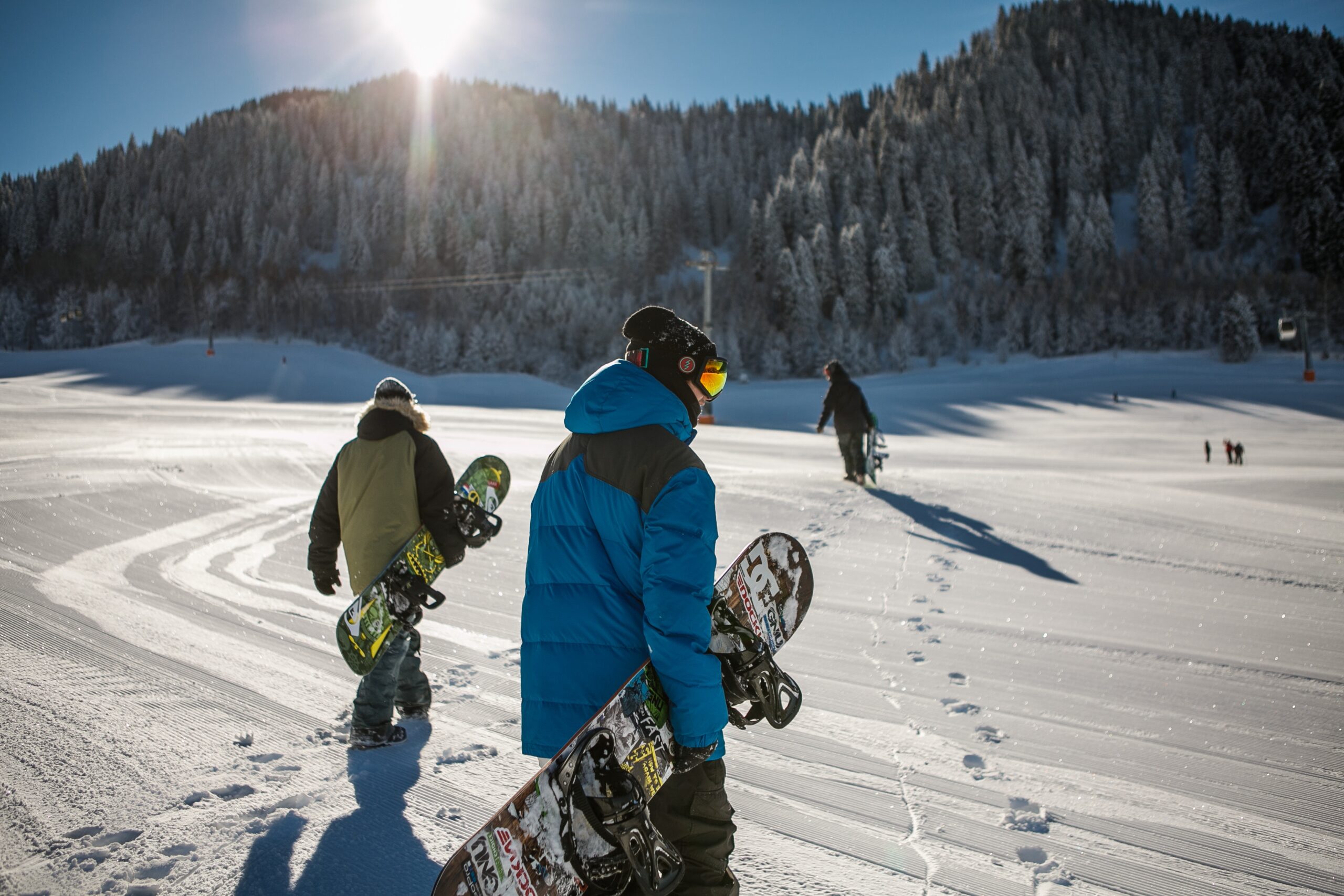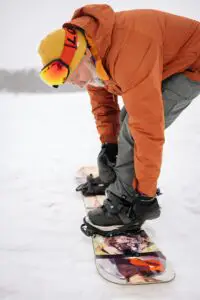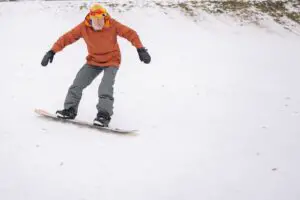Do you dream of carving down the slopes, feeling the rush of wind against your face as you navigate the mountain?
Well, before you strap on those snowboard boots, it’s important to understand the risks involved. While snowboarding can be an exhilarating experience, it’s not without its dangers.
From broken bones to concussions, injuries are all too common on the slopes. But fear not! By taking proper precautions and wearing protective gear, you can minimize your risk and enjoy this thrilling winter sport to its fullest.
Key Takeaways
- Snowboarding can lead to various injuries, such as wrist fractures, knee sprains or tears, head injuries, and shoulder injuries.
- Wearing appropriate protective gear, such as helmets and wrist guards, can significantly reduce the risk of serious injuries.
- It is important to ride within your skill level, be cautious on icy or uneven terrain, and approach obstacles with caution and awareness.
- In the event of an injury, it is crucial to seek immediate medical attention, stay calm, and take necessary actions to ensure your safety.
Common Snowboarding Injuries
One of the most common injuries is a wrist fracture. When you fall, it’s instinctive to put your hands out to break your fall, which can lead to a broken wrist.
Another injury that you should watch out for is a knee sprain or tear. The twisting and turning motions in snowboarding can put stress on your knees, causing injury.
Additionally, head injuries are a significant concern in this sport. Wearing a helmet can greatly reduce the risk of a serious head injury if you take a tumble.
Understanding the Risks
Understanding the risks involved in snowboarding can help you make informed decisions about your safety. It’s important to be aware of what could go wrong on the slopes, so you can take steps to mitigate those risks and have a fun, injury-free experience.
Here are five key points to remember:
- Falling is a common occurrence in snowboarding, so learning how to fall properly can minimize the risk of injury.
- The speed at which you ride can increase the likelihood of accidents, so always stay within your skill level and avoid going too fast.
- Snow conditions play a significant role in your safety. Be cautious when riding on icy or uneven terrain.
- Obstacles such as trees, rocks, or other riders can pose dangers if not approached with caution and awareness.
- Wearing appropriate protective gear like helmets and wrist guards is essential for reducing the severity of injuries.
Safety Tips for Snowboarders
To stay safe while snowboarding, it’s important always to wear a helmet and protective gear. These essential pieces of equipment can protect you from head injuries and other potential dangers on the slopes. But safety goes beyond just wearing the right gear. It’s about being aware of your surroundings and taking precautions to minimize risks.
First, make sure you’re familiar with the mountain’s rules and regulations. This will help you understand where it’s safe to ride and what areas are off-limits.
Secondly, always ride within your skill level. Pushing yourself too hard can lead to accidents and injuries.
Additionally, be mindful of weather conditions. Poor visibility or icy patches can make snowboarding more challenging and increase the likelihood of falls or collisions.
Finally, remember that accidents can happen even when you take all necessary precautions. That’s why it’s important to ride with a buddy or let someone know your plans for the day. Having someone else around can provide support in case something goes wrong.
Protective Gear for Snowboarding
When it comes to snowboarding, wearing proper protective gear is essential for your safety on the slopes. It’s important to understand the significance of donning this gear and how it can prevent serious injuries while you’re out enjoying your ride.
From helmets to wrist guards, there are various types of protective equipment that you should consider investing in to ensure a safe and enjoyable snowboarding experience.
Essential Protective Snowboarding Gear
Wearing the right gear, like a helmet and wrist guards, can help protect you while snowboarding. But what other essential protective gear should you have? Here are five items that will keep you safe and stylish on the slopes:
- Snowboard goggles: These will shield your eyes from wind, snow, and harmful UV rays.
- Knee pads: They provide extra cushioning for your knees during falls or jumps.
- Impact shorts: These padded shorts protect your tailbone and hips from hard landings.
- Back protector: This lightweight armor shields your spine in case of a fall or collision.
- Snowboard gloves: Not only do they keep your hands warm, but they also offer protection against impacts.
By investing in these essential protective snowboarding gear items, you’ll not only reduce the risk of injuries but also feel confident as part of the snowboarding community.
Importance of Wearing Gear
Don’t underestimate the importance of having and wearing the right gear while snowboarding. It’s not just about looking cool or fitting in with the crowd. Wearing proper gear can mean the difference between a fun-filled day on the slopes and a trip to the hospital.
When it comes to snowboarding, safety should always be your top priority. The right gear not only protects you from potential injuries but also enhances your performance on the mountain.
A good helmet will shield your head from impact, while goggles keep your eyes protected from wind and glare. Don’t forget about wrist guards, which can prevent fractures during falls.
Investing in quality gear shows that you take your sport seriously and want to belong to this community of passionate snowboarders. So don’t skimp on safety – wear the right gear and enjoy a worry-free ride down those snowy slopes!
Types of Protective Equipment
Alright, now that we understand the importance of wearing gear while snowboarding, let’s dive into the different types of protective equipment you should consider. Remember, safety is key! Here are five essential items to keep in mind:
- Helmet: Protect your noggin from any potential head injuries. It’s a must-have for every snowboarder out there.
- Goggles: Keep your eyes shielded from the harsh elements like wind, snow, and glare. Plus, they make you look cool!
- Wrist Guards: These handy accessories provide extra support and help prevent wrist injuries during falls or crashes.
- Knee Pads: Give your knees some love by wearing pads that protect them from impact and reduce the risk of injury.
- Impact Shorts: Designed with padding on the hips and tailbone areas, these shorts provide cushioning in case of falls.
Preparing Your Body for Snowboarding
Before hitting the slopes, it’s crucial to prepare your body for the demands of snowboarding.
Warm-up exercises are essential to get your muscles ready and prevent injuries.
Additionally, incorporating muscle-strengthening exercises into your routine will enhance your performance and help you tackle those challenging runs with ease.
Warm-Up Exercises Importance
Warming up before snowboarding is important to prevent injuries. As you strap on your boots and adjust your goggles, take a moment to prepare your body for the exhilarating ride ahead. Here are five warm-up exercises that will not only help you avoid unnecessary pain but also enhance your performance on the slopes:
- Jumping Jacks: Get your blood pumping by performing sets of jumping jacks, which improve circulation and warm up multiple muscle groups.
- Lunges: Strengthen your legs and activate the muscles needed for balance and stability with a series of lunges.
- Arm Circles: Loosen up those shoulders and arms with forward and backward arm circles to improve flexibility.
- Squats: Engage your lower body muscles, including quads, hamstrings, and glutes, by doing sets of squats.
- Torso Twists: Prepare your core for dynamic movements by twisting from side to side, engaging those abdominal muscles.
By incorporating these warm-up exercises into your routine, you’ll feel more confident tackling the mountain while reducing the risk of injury.
Muscle Strengthening Exercises Recommended
To enhance your snowboarding performance, try incorporating muscle-strengthening exercises into your routine. Building strong muscles not only helps you become a better rider but also reduces the risk of injuries on the slopes.
Engaging in regular strength training exercises can improve your balance, stability, and overall control while snowboarding.
Start by focusing on exercises that target key muscle groups used in snowboarding. Squats and lunges are great for strengthening your legs and core, providing stability as you carve through the powder. Deadlifts and hip thrusts work wonders for building lower body strength and power.
Don’t forget about your upper body! Push-ups and pull-ups help build arm, shoulder, and back muscles needed for maneuvering through turns and maintaining balance.
Incorporating these muscle-strengthening exercises into your routine will not only enhance your snowboarding skills but also make you feel more confident out on the mountain. Remember to consult with a professional trainer before starting any new exercise program to ensure proper form and technique.
Get ready to dominate those slopes!
What to Do If You Get Injured While Snowboarding
If injured while snowboarding, don’t panic, but seek immediate medical attention.
Snowboarding is a thrilling and exhilarating sport, but accidents can happen. Whether it’s a minor sprain or a more serious injury, knowing what to do next is crucial.
First, take a deep breath and stay calm. Assess your situation and if you’re unable to move or experiencing severe pain, don’t try to tough it out – call for help immediately.
If you can move without further injuring yourself, carefully make your way off the slope and seek medical attention as soon as possible. Remember, injuries should never be ignored or downplayed; getting prompt medical care will ensure the best outcome for your recovery.
Frequently Asked Questions
How Long Does It Typically Take to Recover From a Snowboarding Injury?
Recovering from a snowboarding injury can vary depending on the severity. It’s crucial to seek medical attention and follow their guidance. With proper care, it may take weeks or months to recover and get back on the slopes fully.
Are There Any Specific Exercises or Stretches That Can Help Prevent Snowboarding Injuries?
To prevent snowboarding injuries, it’s important to incorporate specific exercises and stretches into your routine. Strengthening core muscles and improving balance and flexibility can help you stay safe on the slopes.
Can Beginners Participate in Snowboarding Without a High Risk of Injury?
As a beginner, you may wonder if snowboarding is safe. While there is always a risk of injury in any sport, with proper instruction, protective gear, and gradual progression, you can minimize the chances and have a thrilling experience on the slopes.
What Are Some Common Mistakes That Snowboarders Make That Can Lead to Injuries?
Snowboarding can be exhilarating, but it’s important to avoid common mistakes that lead to injuries. Remember always to wear protective gear, stay within your skill level, and practice proper technique to reduce the risk of getting hurt.
Are There Any Age Restrictions or Limitations for Snowboarding in Terms of Injury Risks?
When it comes to snowboarding, age restrictions or limitations for injury risks don’t discriminate. From young shredders to seasoned riders, everyone can get hurt. So grab your board and join the club!
Conclusion
So, can you really get hurt snowboarding? The answer is yes, but don’t let that scare you away from hitting the slopes.
While there are risks involved, with the right preparation and safety measures, you can minimize your chances of injury. Remember to always wear protective gear, like a helmet and wrist guards.
Take the time to warm up your body before hitting the mountain, and be aware of your limitations.
So go ahead and embrace the thrill of snowboarding. Just remember to stay safe out there!




